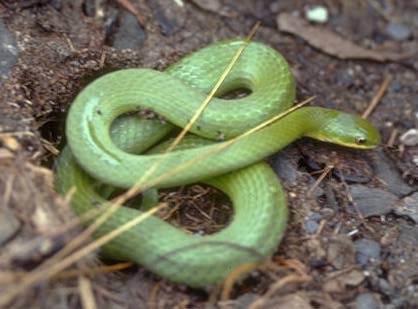Green Snake
Rough Green Snake Scientific Name: Opheodrys aestivus
Thu, 17th April, 2025 - 9:01 am GMT
Sponsor Ads:

Alternative Name
Rough Green Snake Scientific Name: Opheodrys aestivusBasic Info
The Green Snake is known by many names. Common names include the Keeled Green Snake, the Green Whip Snake, the Garden Snake, the Vine Snake, and the Grass Snake. Green Snakes are beautiful and graceful, and can make great pets.
Health
The Green Snake is often difficult to keep in captivity. They have problems with internal and external parasites, and do not easily adapt to new foods. In fact, one of the main problems with keeping Green Snakes in captivity comes from the fact that we don't fully understand their diet. Moths, crickets, grasshoppers, spiders and earthworms are a typical Green Snake diet. In captivity, they should be fed a constant food source twice a week. Crickets are best, due to their availability, however, the crickets should be gut loaded with a special mixture. The crickets should kept with food so they don't nibble at the Green Snake. Green Snakes should never be given food that is wider than their body. A water dish should be provided for the Green Snake, but they prefer to drink water drops off of leaves, so their cage should be misted once or twice a day. Green Snakes should be kept in a habitat with a temperature range from 75 to 80 degrees Fahrenheit. Breeding The Green Snake is difficult to breed in captivity. Breeding occurs in the springtime. Nesting will happen in the summer. Green Snakes choose nesting sites that have sufficient moisture. Green Snakes lay between two to fourteen eggs. Incubation takes roughly 30 to 45 days. If the temperature is cold, the eggs can take 80 days to hatch. When the eggs hatch, the baby snakes will be four to six inches long. Green Snakes are considered to be mature when they reach a size of 14 to 16 inches, which takes about two years.Habitat
Found throughout North AmericaBehavior
Green Snakes are a shy creature. They like to hide from humans, and they are naturally reclusive. While their small and gentle bodies make them very pleasing to hold, Green Snakes generally do not like to be handled. Green Snakes have a good temper, and will rarely attempt to bite a human. Due to their shy nature, the Green Snake needs a habitat with plenty of hiding places. Green Snakes will due best in a densely planted habitat. At maturity, the Green Snake reaches a size of 22 to 46 inches. As their name implies, the Green Snake has a dark green color, much like grass. These snakes do tend to turn a light turquoise blue when frightened or excited. Also, Green Snakes will sometimes have yellow shading on their underside. Green Snakes are slender and agile, and wiggle a lot. Females weigh more than males. They are quite abundant in the wild. Green Snakes can be difficult to keep in captivity, however. This is attributed mostly to a lack of understanding of their diet. Green Snakes are arboreal, but they spend most of their time near ground level, in bushes, meadows and grassy marshes and fields. Green Snakes are good swimmers.Origin
North AmericaHistory
Green Snakes are found throughout North America. They are mostly found in the eastern United States, in states such as Florida and Connecticut.Common Foods
N/ASponsor Ads:
Isn't it strange that the same people who laugh at gypsy fortune-tellers take economists seriously. -- Unknown
Green Snake
Coded by: BGID® | ALL RIGHTS RESERVED Copyright © 2000-2025
Disclaimer | Privacy | Report Errors / Contact | Credits


 President of the United States of America - Real Estate mogul, Pageant owner and now one of the most controversial men in political history.
President of the United States of America - Real Estate mogul, Pageant owner and now one of the most controversial men in political history.  Politician, US Vice President and President of the USA - Joseph Robinette Biden Jr.
Politician, US Vice President and President of the USA - Joseph Robinette Biden Jr.  versus
versus  Russia: 'The Evil Empire'? Are they all that bad or is it just the USA trying to portray Russia as bad because they are a world power with land bigger and a society very different from the USA ideal?
Russia: 'The Evil Empire'? Are they all that bad or is it just the USA trying to portray Russia as bad because they are a world power with land bigger and a society very different from the USA ideal?  Global warming has been in and out as the "latest" hot topic for many years. It is, according to modern scientists, the result of man-made industrial pollutants, clearing forested areas, agriculture, etc. But now they are thinking it started way before the Industrial Revolution...
Global warming has been in and out as the "latest" hot topic for many years. It is, according to modern scientists, the result of man-made industrial pollutants, clearing forested areas, agriculture, etc. But now they are thinking it started way before the Industrial Revolution... 
 Corona virus
Corona virus 
 Users with wide screen monitors can benefit from more content on every page.
Users with wide screen monitors can benefit from more content on every page.